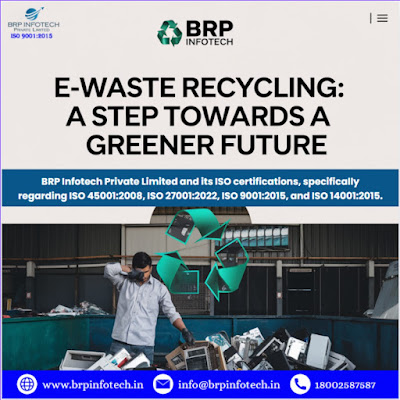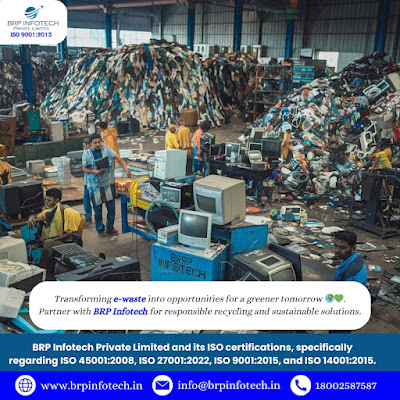As Bengaluru grows into India’s tech capital, the city faces a significant challenge — managing the ever-growing volume of electronic waste (e-waste). Enter BRP Info Tech, a leader in sustainable e-waste management committed to turning this challenge into a solution for the future.
BRP Info Tech’s approach to e-waste is rooted in innovation and responsibility. Using state-of-the-art recycling technology, the company efficiently recovers valuable metals and materials from old electronics, contributing to a circular economy. What makes them stand out is their focus on eco-friendly practices and secure data destruction, ensuring that both the environment and sensitive information are protected.
By embracing sustainable e-waste practices, BRP Info Tech is not just cleaning up the city — they are shaping Bengaluru’s green future, one device at a time.
The Future of E-Waste Management In Bengaluru
🌱 Innovations in Recycling and Repurposing Electronics
By BRP Info Tech
In today’s hyper-connected world, electronics are evolving faster than ever—but so is e-waste. At BRP Info Tech Bengaluru, we believe that sustainability and innovation must go hand in hand. That’s why we’re leading the charge in revolutionizing how electronics are recycled and repurposed.
🔄 Smart Disassembly
Gone are the days of manual dismantling. We're investing in semi-automated systems that speed up the breakdown of complex devices, separating components with high precision. This ensures more materials—like precious metals, plastics, and rare earth elements—are recovered and reused efficiently.
⚙️ Refurbishment Tech
Many discarded electronics still have life left in them. Our refurbishment division uses diagnostic AI tools to detect faults, repair components, and restore devices for reuse—giving tech a second life and reducing landfill waste.
🔋 Battery Recovery & Safe Disposal
With lithium-ion batteries becoming more common, proper handling is critical. We employ advanced thermal and chemical processes to recover valuable materials safely, ensuring no hazardous waste leaks into the environment.
🌍 Eco-Design Collaboration
We're also working with manufacturers to promote eco-friendly product designs—making future electronics easier to recycle, repair, and reuse.
At BRP Info Tech, innovation isn’t just about technology—it’s about responsibility. Together, we can close the loop on e-waste and build a greener digital future.
BRP Info Tech’s Eco-Friendly Approach to E-Waste Management in Bengaluru
As Bengaluru continues to grow as a tech hub, the challenge of electronic waste (e-waste) management becomes more pressing. BRP Info Tech Bengaluru is stepping up to the plate with a green revolution in the city’s e-waste sector. By employing eco-friendly methods, BRP Info Tech is not just handling waste, but transforming it into valuable resources, while also reducing environmental impact.
With its state-of-the-art recycling facilities, the company ensures that e-waste is processed responsibly. By safely extracting metals, plastics, and rare earth elements, BRP is contributing to the circular economy, reducing the need for raw material extraction. Furthermore, the company ensures that harmful substances like mercury and lead are carefully handled, preventing them from contaminating the environment.
Through its commitment to eco-friendly practices and data security, BRP Info Tech is leading Bengaluru towards a greener future, one device at a time.
From E-Waste to Eco-Warrior: BRP Info Tech’s Sustainable Journey in Bengaluru:-
As Bengaluru continues to thrive as India’s tech hub, it also faces an escalating e-waste challenge. Enter BRP Info Tech Bengaluru, a company that is transforming this problem into an opportunity. With a mission to not only recycle but repurpose electronic waste, BRP Info Tech is leading a sustainable revolution in Bengaluru’s waste management.
Through cutting-edge recycling technologies, the company efficiently extracts valuable materials like metals, plastics, and rare earth elements from discarded electronics. But what truly sets BRP Info Tech apart is its focus on eco-friendly practices and data security, ensuring safe disposal and data destruction with every device.
From reducing harmful environmental impacts to promoting a circular economy, BRP Info Tech is more than just an e-waste management company — it’s an eco-warrior, committed to building a greener, cleaner Bengaluru for future generations.
The Hidden Cost of Electronics — And How BRP Is Solving It
In today’s fast-paced world, technology has become essential. Yet, with every new device comes a hidden cost — e-waste. Electronic waste, often overlooked, has serious environmental and health implications. As gadgets like phones, laptops, and televisions become obsolete, they contribute to growing piles of toxic waste, polluting our planet and leaching harmful chemicals into soil and water.
But BRP Info Tech is tackling this problem head-on. With its state-of-the-art e-waste recycling facilities, BRP is not just collecting and disposing of old electronics — they’re giving these devices a second life. Through responsible recycling, BRP extracts valuable materials like gold, silver, and copper, reducing the need for harmful mining. Moreover, they ensure that hazardous materials like lead and mercury are safely handled, preventing environmental damage.
What truly sets BRP apart is its commitment to data security. In an era where privacy is paramount, the company guarantees secure data destruction, ensuring that personal information doesn’t end up in the wrong hands.
By responsibly managing e-waste, BRP Info Tech is reducing the hidden costs of electronics and driving us toward a cleaner, safer, and more sustainable future.
Read Also:-
E-Waste Recycling company in Bangalore | BRP Infotech
E-Waste Recycling Company in India | Go Green with BRP Infotech
visit:- https://brpinfotech.in/
.png)








